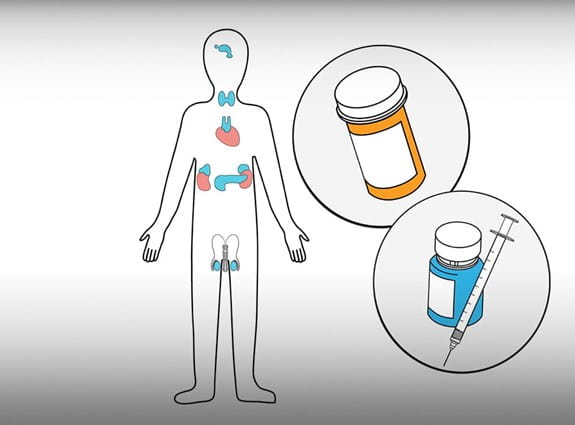The basics of hormone therapy
[The main character appears on screen. He is a person with cancer.]
Narrator: If you’ve been diagnosed with cancer, you may be told you need hormone therapy.
[The main character sits with his doctor in her office. Images of a radiation machine and an IV bag and pill bottle appear beside him. A thought bubble with a question mark appears above his head.]
Narrator: You’ve probably heard of treatments like chemotherapy and radiation – but what’s hormone therapy?
[An outline of a human body shows the organs and glands that make hormones. Red and blue lines representing blood and hormones travel throughout the body.]
Narrator: To start, let’s talk about hormones. Hormones are chemicals that move through your blood and control certain cells and organs.
[The single body outline splits into 2 body outlines – one with ovaries and one with testicles.]
Narrator: You may know some of the hormones your body makes, like estrogen, progesterone and testosterone. These are produced by the ovaries and testicles and are involved in reproduction.
[The body outlines return to a single outline with testicles. Red rings radiate around the testicles to suggest that the hormones made there aren’t working properly.]
Narrator: When you have cancer, some hormones may not work properly. That’s where hormone therapy comes in.
[A pill bottle and a vial with a syringe appear beside the body outline to represent hormones made in a lab.]
Narrator: Your body makes natural hormones throughout life, but hormones can also be made in a lab and used for treatment.
[An outline of a human body that is filled in light blue appears on one side of the screen. Healthy cells and cancer cells start to fill the screen beside and behind it. The healthy cells are round and yellow while the cancer cells are dark blue and abnormally shaped. The cancer cells begin multiplying, but they slow to a stop and begin to fade out as hormone levels change, which is shown by the light blue colour in the body outline going down.]
Narrator: Hormone therapy can be used to treat cancers that need hormones to grow, such as some prostate and breast cancers. It works by changing the level of hormones in the body, which can help stop or slow the growth of cancer cells.
[The main character accepts a prescription bag from a pharmacist. Above them, a drawing of a hormone’s chemical structure appears in a circle with a red line through it, representing the suppression of a hormone.]
Narrator: Hormone therapy may be given as pills or an injection. These are called hormone suppression drugs because they stop the body from making a certain hormone.
[The main character lies on a table in a surgical room with a blanket over him. His surgical team stands around the table.]
Narrator: Hormone therapy can also be a type of surgery. For example, a surgeon may remove a gland or organ that makes a hormone.
[The main character lies on a table under a radiation machine. The machine bends toward him, preparing to give radiation therapy.]
Narrator: Finally, hormone therapy can be given as radiation to destroy cells that make a hormone.
[The main character sits with his doctor in her office. Images of a gloved hand holding a scalpel and a machine giving radiation therapy appear beside them.]
Narrator: Hormone therapy is usually given before or after other treatments. It may be used to shrink a tumour before surgery or radiation to lower the risk that cancer will come back after treatment.
[The screen splits into 3 scenes. In the first scene, the main character is having coffee with his friend. In the second scene, he is lying in bed, feeling unwell. In the third scene, he is walking in a park with his wife.]
Narrator: Side effects can happen with any type of cancer treatment, but everyone’s experience is different. Common side effects of hormone therapy are fatigue and weight changes. Hot flashes, treatment-induced menopause, sexual and fertility problems and diarrhea are also possible.
[A calendar shows May 17. The pages begin flipping slowly then more quickly to show the passing weeks and months.]
Narrator: You may have side effects during, right after or weeks after hormone therapy. Sometimes late effects develop months or years later.
[The main character sits at a table with his doctor and surgeon. He has a notebook open in front of him and a speech bubble appears above his head as he asks questions.]
Narrator: Most side effects don’t last, but some do. Talk to your healthcare team about how you feel during and after hormone therapy. Don’t be afraid to ask your doctor questions about hormone therapy.
[The Canadian Cancer Society logo appears above the contact number and website. The BMO bank logo appears below as a sponsor of the Cancer Basics videos.]
Narrator: The Canadian Cancer Society is also here to help. Visit cancer.ca or call us at 1-888-939-3333.

